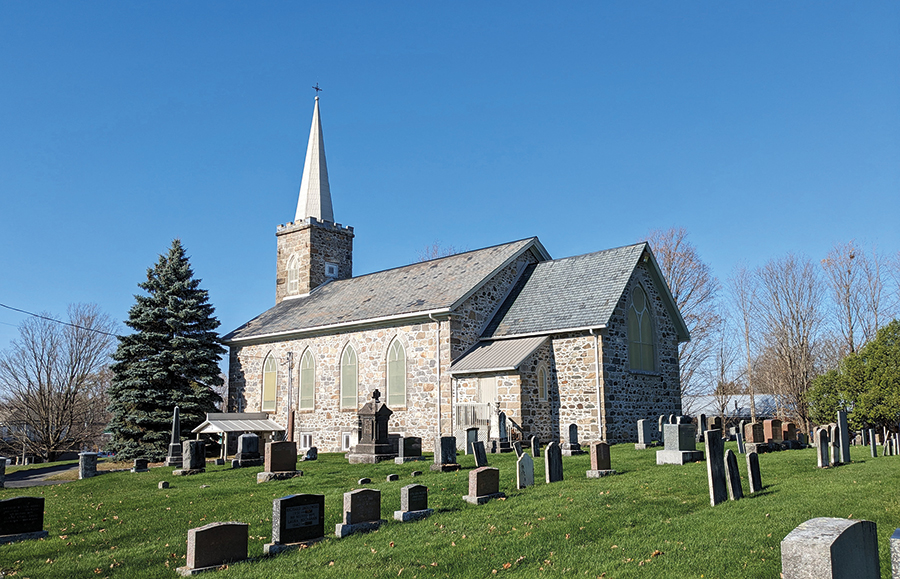No Final Rest

Un texte de Heather Darch
Paru dans le numéro Automne/Fall 2024
Publié le : 15 août 2024
Dernière mise à jour : 16 août 2024
It is hard to believe that body-snatching was once a thing and that these body-snatching stories happened in small villages like Dunham.
Abijah Hubbell (1737-1821) had a life that saw him on the move throughout his 85 years (and beyond!). He was born in Fairfield, Connecticut, to Ebenezer Hubbell (1687–1761), and Sarah Titherton (1696–1788). The Hubbells and Tithertons were well-established in Fairfield, and it was unlikely that they ever considered moving from their homes. Largely an agrarian society, relocation was not an option for most people in the New England colonies until the American Revolution.
On July 7, 1779, British troops attacked Fairfield. Considered to be a “haven for Rebels,” they burned the town to the ground. By the end of the day, 97 homes, 67 barns, 48 stores, two schools, a courthouse, two meeting houses and the county jail had been destroyed. Citizens like the Hubbells who lost their homes, were offered financial compensation or an equivalent value of land from the half-million acres, in what is now part of Ohio, called the Connecticut Western Reserve.
Abijah Hubbell was a middle-aged farmer by this time and chose to accept the payment and move with his wife Hannah White (1737-1782) and his children, to Salem, New York: a 260 kilometre trek over many days of travel. Ten years later, the widowed Abijah moved even further north to Georgia, Franklin County, Vermont. These migratory patterns were common for families during post-Revolutionary War America as people sought out safe havens and tried to re-establish their livelihoods and family connections in the newly formed United States. Over the years, the Hubbell children married and established their own homesteads and Abijah lived with his youngest and unmarried son Samuel.
While the Census records indicate that Mr. Hubbell was in Vermont until 1820, he moved to Dunham, Quebec in that same year with Samuel, who was likely looking for better economic opportunities. A year later, Abijah died and was laid to rest in Dunham’s All Saint’s Anglican Church cemetery. Sadly, his story doesn’t end there. In her diary, Dunham resident Caroline Barnes Crosby wrote:
September 15th 1821. I think, was the dedication of Allsaints [sic] Church, in Dunham. I was then in my 15thyear. The same fall I believe, an old man by the name of Hubble died, was buried in the churchyard, and his body was stolen for dissection, the grave being left entirely open, the clothes and coffin were scattered about in a most shameful manner, to the great mortification of his children, and friends. He was very aged and remarkable for piety.
Shockingly, grave robbers stole Abijah Hubbell’s newly interred body for anatomical teaching. Criminal statistics reveal little about bodysnatching in this era because even when detected, the crime was never prosecuted. Thieves would take only the body as theft of the “private property,” such as clothing and jewellery, was considered the egregious and punishable offence, not the actual removal of the corpse.
Over the course of the century as enrollment increased in medical schools, and as surgery became progressively important to the medical profession, the demand for cadavers also grew. Medical students turned to grave robbing and smuggling bodies back to their universities. The “resurrectionists” as they were known, were “an artful bunch.” Indeed, dissection was a sneaky business.
Medical schools created a lucrative traffic in corpses. Montreal anatomist Francis J. Shepherd recollected that the McGill Faculty of Medicine offered between “thirty to fifty dollars” per corpse. Not surprisingly, such irreverent tampering with the dead led to widespread public outrage against the thieves and the medical institutions. In the majority of cases, the bodies came from rural cemeteries or from poor minority communities. Distantly located or impoverished families could not bear the costs to search for their loved-ones or for their re-internment. One physician stated that “it was rare for him to ever dissect a white body during his school days at McGill.”
Decades past before the government took any action, but on March 30, 1883, the Anatomy Act of Quebecwas introduced. The legislation enforced punishments for body-snatching and clarified and strengthened the regulations for respectful academic medical study. By March 1884, not a single case of grave robbing was reported in Quebec. While too late for Mr. Hubbell, the ghoulish era of bodysnatching was over.
Heather Darch
Sources:
The National Archives in Washington, DC; Washington, DC; First Census of the United States, 1790; Salem, New York; Series: M637; Roll: 6; Page: 189; Family History Library Film: 0568146
Connecticut Historical Society, The British Burn Fairfield https://connecticuthistory.org/british-burn-fairfield/
1800 Census: Georgia, Franklin, Vermont; Series: M32; Roll: 51; Page: 444; Image: 249; Family History Library Film: 218688
1810 Census: Georgia, Franklin, Vermont; Roll: 64; Page: 286; Image: Vtm252_64-0522; FHL Roll: 0218668
1825 Census of Lower Canada [database on-line]. MG 31 C1; film number 2443957; p. 839.
Bibliothèque et Archives Nationales du Québec; Montréal, Quebec, Canada; Collection: Archives Des Notaires du Québec; District: Bedford; Title: Clement, Edmond (1836-1871) 1853, Last Will and Testament Polly Geer, wife of the late Samuel Hubbell.
No Place to Call Home: The 1807-1857 Life Writings of Caroline Barnes Crosby (Chronicler of Outlying Mormon Communities) eds. Lyman, Ward-Payne and Ellsworth. Utah State University press, 2005. Thank you, Anne Lipowski for this source.
Royce MacGillivray, Body-Snatching in Ontario, https://tspace.library.utoronto.ca/bitstream/1807/17619/2/body%20snatching%20Ontario%20CBMH.pdf
Matthew Rankin, Anatomically Incorrect: Bodysnatching in the 19th Century, https://canadashistory.ca/explore/science-technology/anatomically-incorrect-bodysnatching-in-the-19th-c
Montreal Daily Witness, 29 January 1878, p. 4 https://numerique.banq.qc.ca/patrimoine/details/52327/3624872

